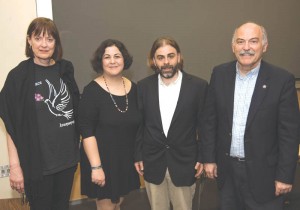
Aren Perdeci, and Prof. Barlow Der Mugrdechian.
Photo: Hourig Attarian
Marine Vardanyan
Staff Writer
Described as the first Armenian Genocide movie to make a Turkish audience cry, Lost Birds premiered in Fresno on Friday, April 7, as part of the CineCulture Film Series. The Armenian Studies Program, a sponsor of the screening, invited directors Ela Almayac and Aren Perdeci from Istanbul to speak about their film. Armenian Studies Program Coordinator Prof. Barlow Der Mugrdechian introduced the film and the directors and discussed the cooperative work with Dr. Mary Husain, faculty director of CineCulture, in bringing Armenian-themed films to the series.
A standing-room only audience of more than 325 people filled the Fresno State Leon S. and Pete P. Peters Educational Center Auditorium, creating a sense of anticipation and excitement.
Lost Birds premiered in Istanbul to mainly Turkish audiences and many of those Turks were moved to tears by the film. They were motivated to ask the directors why they knew nothing about the Armenian Genocide.
A film that took five years to complete, Lost Birds presents the fairytale-like story of two inseparable siblings, Bedo and Maryam, who live in bliss with their mother and grandparents in a peaceful Armenian village. Maryam and Bedo often play in their secret cave, where their imagination transforms them into a princess and a knight. One day, upon returning from their playful venture in the cave, the siblings find their village deserted. Maryam and Bedo set out on a journey to find their family, unaware that the Turkish gendarmes have deported all the Armenians. This is the beginning of the Armenian Genocide, which is never explicitly mentioned in the film.
Turkish directors Ela Alyamac and Aren Perdeci pursued this brave endeavor despite risk of punishment. In Turkey, discussing the Armenian Genocide could be deemed as violating Article 301 of the Turkish Penal Code, “insulting the Turkish nation.”
Director Aren Perdeci explained how his Armenian heritage was a motivator for him to make such a film. For the safety of the actors and production team, which included two Armenian theatre troupes from Istanbul, the film was shot under the pretense of a love story. When asked about future opportunities to shoot films regarding the Genocide in Turkey, Alyamac replied, “The window has closed.”
Alyamac and Perdeci shot the film with stunning cinematography depicting the towns of Kayseri and Güzelyurt, and the emotional musical score included works from the composer Komitas Vardapet, oudist John Bilezikjian, and others.
Candles were a recurrent image in the film. “More than 5,000 candles were made,” related Perdeci, as he explained the three months he dedicated towards finding the best candles for the film. They had to burn in just the right way to produce the desired effects, especially in a scene where no artificial light was utilized.
Lost Birds was filmed in the Turkish language, with English subtitles. Armenian was spoken in some of the scenes in Maryam’s and Bedo’s home, as well as during the Easter services at the Armenian Church. The directors explained the historical foundation of their decision, “When they spoke in secret, it was in Armenian, but when they were among Turks, it was Turkish.” Alyamac and Perdeci were very committed to creating a historically accurate product.
With the help of their history consultant, Dr. Vahe Tashjian (director of the Houshamadyan Project), and an interview with a 95-year-old Genocide survivor, the film was able to capture specific details of the time period. The main locations of Lost Birds, the church, orphanage, and Maryam’s and Bedo’s home, were all existing structures in 1915, restored by the directors especially for their film. The home, discovered in a village near Kayseri, was one of the only Armenian homes that was still standing. They were able to utilize the house with the condition that they restore it to its original condition. The costumes of the actors were designed using authentic materials and motifs from the period of 1915. This is a testament to the directors’ attention to detail. Another example was the mother’s gown, which was a genuine 100 year-old dress. The film successfully conveyed a feeling of authenticity as viewers appreciated the thoughtfulness and diligence of the work.
“We wanted to make a film that children could watch without being traumatized,” said Alyamac. Indeed, the film introduces the dark chapter of history in a manner that avoids violent scenes and explicit references to the Genocide. Instead, Lost Birds focuses on the relationships and lives that were forever changed because of the Genocide of 1915.
“Lost Birds, for people who don’t know about the history, is a good starting point,” said Perdeci.
 Hye Sharzhoom Armenian Action
Hye Sharzhoom Armenian Action